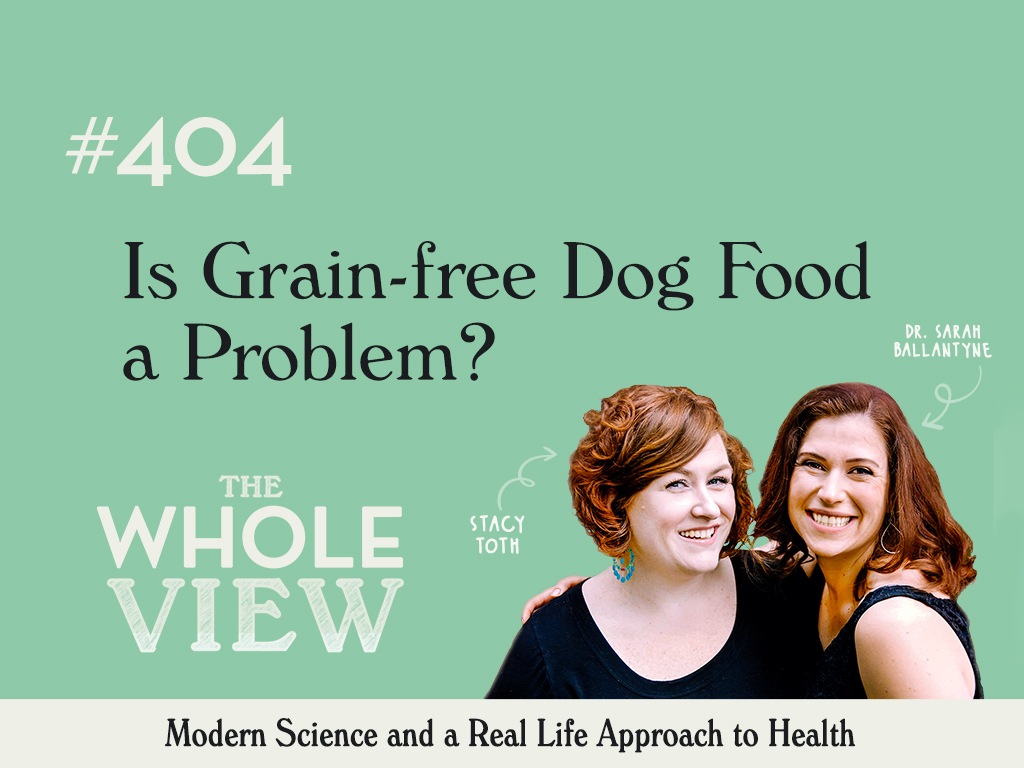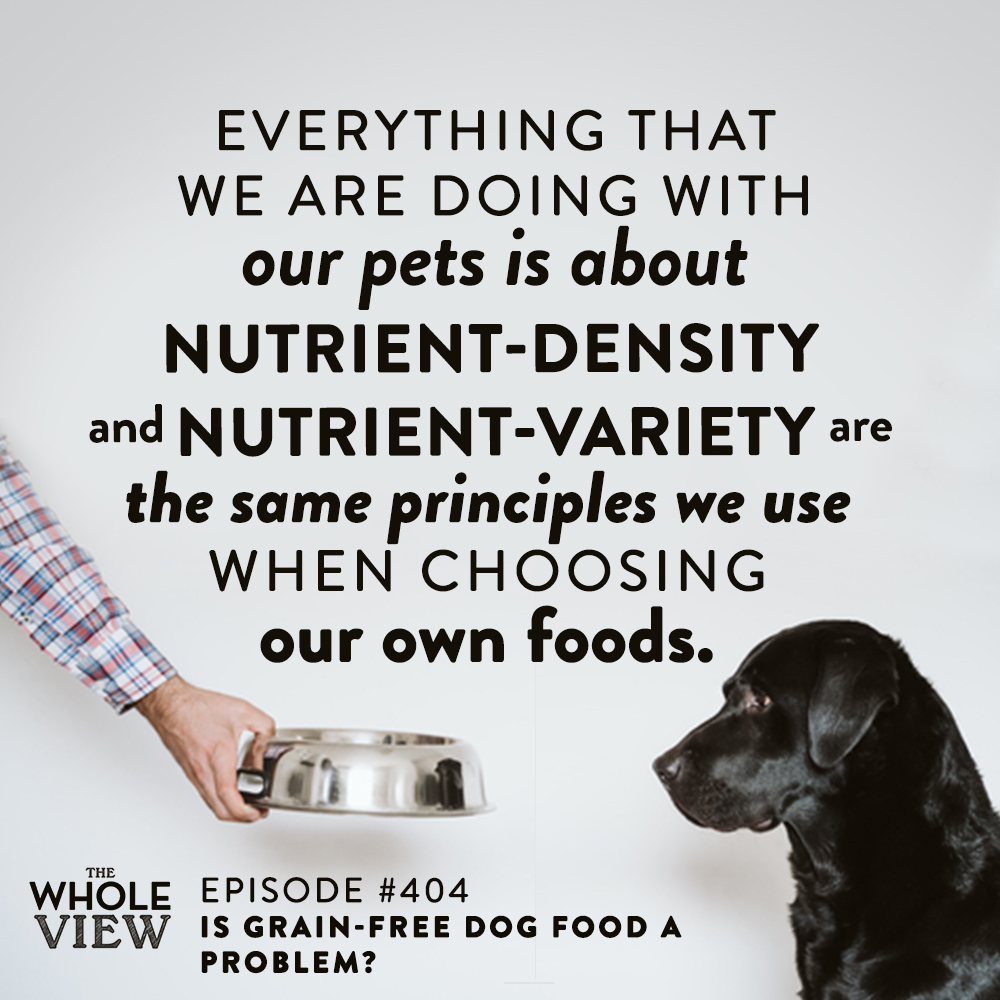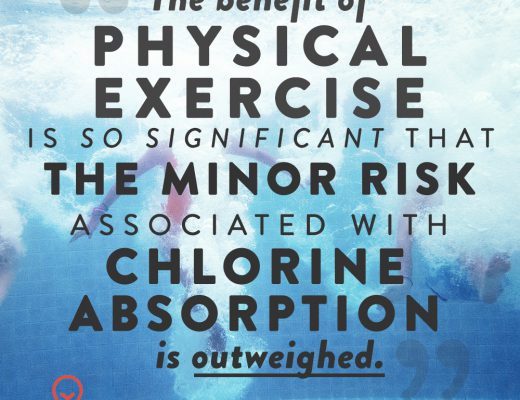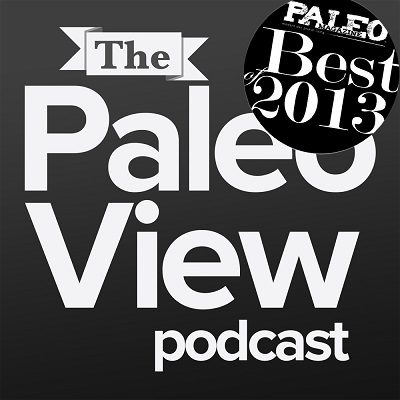
Welcome to episode 404 of The Whole View! This week Stacy and Sarah are sharing all about how they are feeding their beloved pups. What brands do they love, how do they prep and serve their food, do they supplement, and why do they make the dietary choices they do? All of this and more in episode 404!
If you enjoy the show, please review it on iTunes!
The Whole View, Episode 404: Is grain-free dog food a problem?
Welcome back to episode 404 of the Whole View. (0:27)
Stacy is almost getting use to saying that.
It has been a month since they changed over.
Sarah is proud that she has been using the correct name of the podcast, especially since she has puppy sleep deprivation.
Stacy is feeling well, and thanks everyone for the positive vibes they have been sending her way.
Her heart rate is completely back to normal, and she is now symptom-free.
Even though you recover, it still takes time to rebuild and get back to full strength.
It takes time for inflammation in the lungs to heal.
Sarah has been wanting to do antibody testing to see if she had it.
The quality of the antibody tests is a huge range, so Sarah is yet to research this just yet.
Stacy firmly believes that knowledge is power.
From her entire coronavirus experience, that is really her big takeaway.
Stacy is so excited to host another pet show this week!
The last pet show they hosted felt like an uplifting conversation.
Remember, while Stacy and Sarah will refer to their dogs in this episode, they are also both cat owners and love their cats dearly as well.
They are talking about pets in general.
Listener’s Question
This was a question that Stacy wanted Sarah to cover for a while. (9:09)
However, just recently, this question was received from a podcast listener, before the last pet show was hosted.
When Sarah announced that she was getting a dog, this was the most common question she received.
What do I feed my dog?
Ashley says, “Hi Sarah and Stacy! I started listening to the podcast several years ago while I was living in New York City.
Every evening after work I would get on the train, put in my headphones, and listen to an episode.
I guess I am one of the listeners you are always apologizing to for the early episodes.
I have to say I have truly enjoyed them all and have learned so much valuable information.
Thank you for all your hard work to both educate and entertain your listeners, I feel like we are friends at this point and I still look forward to a new episode every week.
The Paleo View is my favorite podcast hands down!
As a person eating a nutrient-dense, anti-inflammatory diet myself, I am wondering how to feed my dog in the same way.
My husband and I recently added a Bernedoodle puppy to our family and he is the most adorable and mischievous little guy.
There is so much conflicting information out there about what diet is best for dogs – they need grains, they don’t need grains, raw is best, raw is dangerous.
Most dog food is so highly processed and contains ingredients that to me seem highly inflammatory and nutrient-poor.
The organic and grain-free foods look good on paper, but then I read about concerns with grain-free diets and heart problems in dogs.
I like the idea of a raw diet, but that also requires a lot more work on my part to source and prepare his food which just isn’t practical for my life right now.
I would love to know the science on this topic so I can feel confident in what we are feeding our dog so that he can continue to be a healthy and happy pup! Please help!”
Knowledge is Power
Stacy is excited for Sarah to help. (12:11)
After a bit of research when Matt and Stacy for Penny, Stacy made a food choice and Sarah looked into as she was preparing to get a pup.
Sarah found that it actually isn’t that bad of a food choice.
Stacy has had two veterinarians that a grain-free diet for a dog isn’t good and that a raw diet for a dog is not good.
So when Stacy asks what is a good option and why the foods that they recommend are exactly as Ashley indicates.
They are foods that would be highly inflammatory.
After seeing Penny’s symptoms when she was adopted and knowing what kind of diet she was on, Stacy knows that she has sensitivities from her inflammatory diet.
So Stacy is excited to learn more about what is an ideal diet.
As a reminder to listeners, just as we humans make our own choices, we do the best that we can with the knowledge we have.
If you decide that you are going to transition your pet to a new food after this, or maybe not, there is no shame or guilt.
This is not Stacy and Sarah telling listeners what you need to do.
However, this is knowledge for you to be empowered to make your own choices.
Neither Stacy or Sarah are medical professionals, and information on this podcast should not be treated as medical advice.
Sarah thought it would be interesting to answer Ashley’s question with the ancestral diet approach.
This is so consistent with how we approach food.
Meeting the body’s nutrient needs is the primary criterion for a healthy diet.
So what are the nutritional needs of a dog?
And what is the ancestral diet that would help to meet those?
Let’s Start with Wolves
So let’s start talking about what wolves eat. (17:34)
Dogs and the modern gray wolf share a common extinct ancestor.
There is great debate among biologists about whether or not dogs and wolves are the same species.
Some biologists believe that dogs are a subspecies of the gray wolf.
While other biologists believe that they are their own species and that wolves and dogs are separate species.
Wolves are scavengers and hunters, and they really eat anything they can get.
They always eat the whole animal, and organ meat is the first thing they consume.
The highest levels in the pack get the most nutritious diet so they stay the healthiest and the fittest.
Then they eat the ribs, a lot of small bones, and nearly all of the hide.
Even the large bones are gnawed on.
The other thing that Sarah found really interesting is that by eating the stomachs and the intestines they are getting a fair amount of partially digested plant matter.
They also eat grass.
Researchers believe that wolves eat grass to purge the intestines of parasites.
The earliest evidence of dog domestication is about 40,000 years old.
And the earliest proof of domesticated dogs is about 14,000 years old.
Domestication has more points of change, in terms of genetics, than agriculture does in humans.
The genetic differences refer to changes in the nervous system, and it is thought that these are all underlying the behavioral changes that were central to dog domestication.
There are also ten genes that have changed that all have key roles in digestion and fat metabolism.
These genetic changes show a dog’s ability to digest starch relative to the wolf.
There are these well-measured changes in dogs compared to wolves that have made them more adapted to eating more starch.
This doesn’t mean that starches are the foundation for their optimal diet.
However, it implies that they need a little bit more starch and carbohydrate than the wolf.
Facultative Carnivores
So not a grain-based diet, as dogs are still considered facultative carnivores. (25:29)
Facultative carnivores are species that are not strict carnivores.
They eat some plant foods in addition to animal foods.
However, they can’t thrive on a truly omnivorous diet.
They still need to eat a dominant amount of calories from meat.
But they are well adapted and still need a small amount of their diet to come from plants.
Where science is pointing is that really the optimal diet for dogs is similar to wolves, with a whole-prey, whole-animal, approach.
Eating really every bit of the animal that is edible.
This should probably make up 85% of the diet, with a variety of plants making up the other 15%.
Which leads really well into the question of raw vegetables versus cooked.
Sarah shared on the research she did and specifically pointed out the details found from this study.
They showed that the safety profile of raw diets is very high.
Stacy asked about the risks associated with raw dog food being contaminated and recalled.
Sarah pointed out that there have been tons of recalls on grain dog food.
Stacy noted that it is helpful to be armed with information when you visit the vet.
If your vet isn’t working for you, remember that they are providing a service to you and you are choosing to go there.
You can always find another one when you feel that their beliefs don’t align with your beliefs.
Sarah shared some data on the recall rate for dog food.
Raw diets are highly digestible.
Processed kibble diets were not as digestible.
There was a 10% difference between the two.
High quality cooked diets were also found to be highly digestible.
So it wasn’t a question about whether or not the ingredients were raw, so much as how processed they were.
Sarah also referred to this study.
Personally, Sarah cares much more about the quality and processing of the ingredients, instead of whether or not each ingredient is cooked or raw.
This thesis also went into how the fiber content of food impacted digestibility.
This made a case for animal fiber.
You don’t want too much fiber, which decreases digestibility.
However, you do need some fiber, which should come from some plant foods.
When Sarah was doing this research she was expecting that they would be better adapted to consume cooked diets, and she shared why.
Grain-Free Foods and Diet-Induced Dilated Cardiomyopathy
The other part of Ashley’s question asks about the link between grain-free food and diet-induced dilated cardiomyopathy.(43:38)
This was a huge research point for Sarah because she doesn’t allow gluten in her house.
In July 2018, the United States Food and Drug Administration (FDA) issued a public notification about an uptick of reports of canine dilated cardiomyopathy (DCM) – a type of heart disease that can lead to congestive heart failure.
Symptoms include enlarged heart, decreased energy, lethargy, cough, difficulty breathing, loss of appetite, and episodes of collapse.
However, many dogs will not show symptoms of the disease right away.
If you suspect that your dog is affected, consult your veterinarian immediately.
In the FDA’s July 2019 update on diet and canine heart disease, they examined labels of dog food products reported in DCM cases to determine whether the foods were “grain-free” (defined as no corn, soy, wheat, rice, barley or other grains).
They also looked at whether the foods contained peas, lentils, chickpeas, beans, or potatoes (including sweet potatoes).
Their report states that 91 percent of foods reported in DCM cases were grain-free, 93 percent of reported foods contained peas and/or lentils, and 42 percent contained potatoes/sweet potatoes.
91% were eating grain-free food.
This is research that is ongoing.
The most likely mechanism is that that is some kind of antinutrient in legumes blocking taurine absorption.
Taurine is an amino acid found exclusively in meat.
It is not considered an essential nutrient for dogs because they can synthesize their own.
Some breeds appear to be predisposed to taurine deficiency from low-taurine diets.
Taurine deficiency is one potential cause of DCM.
Golden retrievers made up 20% of the effected dogs from diet-induced dilated cardiomyopathy.
There were a ton of other breeds represented in the findings.
Many of the dogs have responded to taurine supplements, even if they didn’t appear to be taurine deficient.
Taurine supplementation may be more effective as a prophylactic than a treatment, but this still needs to be studied.
So the culprit isn’t necessarily the lack of grains in the diet, but the fact that grain-free don’t automatically mean good, high-quality, or nutritionally balanced.
Remember, this is still an active area of research.
Look for options where legumes, especially peas and lentils aren’t in the top 10 ingredients.
Taurine is naturally high in organ meat.
There are no gluten-free dog foods that are also grain-free.
77 million dogs in USA, DCM reported in 560 probably under-reporting but still very low incidence.
CF 50% of dogs will get cancer in their lifetime.
What Sarah Feeds Soka
Sarah is looking to reduce the risk of everything bad that can happen to her. (55:21)
This was an area of high-importance to Sarah when they were preparing to get a dog, and she did a ton of research on her options.
Sarah was looking for dog food that was nutrient-dense, with a whole prey ratio of animal ingredients at 85%.
Probiotics were also on her wishlist.
She was also looking for a food that didn’t have too much protein.
Too much protein can be hard on a dog’s kidneys, so Sarah was looking for a brand with no more than 40% protein.
If the brand had legumes, they had to be at least eleven ingredients down.
The other thing that Sarah is doing is giving her pup a mixed diet so that not every meal is kibble.
She is buying a different flavor every time, of the same brand that she found.
Then Sarah is also doing a rehydrated freeze-dried food, which preserves nutrients better than the canning process.
So her dog is getting one wet can food meal a day.
In addition, Sarah’s dog is receiving training treats and chews.
The brand that Sarah selected is Orijen.
However, they are not the only good brand out there.
Orijen checked every single box of what Sarah was looking for, which was such a relief to find.
On the advice of her vet, Sarah is also giving Soka a taurine supplement.
The supplement is vetriscience cardio strength, which contains Carnitine, Taurine, Glycine, vitamin E, EPA, coQ10, GLA, vitamin B9, Magnesium, Potassium, and Selenium.
Sarah is mixing things up with training treats and Soka’s favorite is pastured turkey breast, cooked in the Instant Pot.
The other high-quality training treats that Soka likes are Grizzly’s Smoked Wild Salmon, Pupford Liver Training Treats, and Pupford Sweet Potato.
And Sarah just ordered Vital Essential Freeze-Dried Minnows and is excited to have her dog try those.
Sarah shared some of her training tricks and current approach.
So with, a focus on a nutrient-dense approach, the whole-prey ratio, and then round out her diet with mixed, diverse add-ins.
Sarah rounds it out with as many high-quality ingredients, using different training treats each time.
Soka is also getting natural chews like grass-fed beef bone (K9 Connoisseur), naturally-shed deer antler (Whitetail Naturals), and beef trachea.
Everything that Sarah is doing with Soka is about nutrient-density and nutrient variety, which are the same principles of how she chooses her own foods.
Stacy loves that all of the brands they pick are helping with the sustainability and the respecting of animals that she feels so passionate about with our food supply chain.
Eating nose to tail is so important.
Thank you dogs for helping us respect the whole animal!
What Stacy Feeds Penny
Like Stacy mentioned, they really struggled for almost a year in figuring out what to feed Penny. (1:06:05)
They started off transitioning her to a higher quality kibble because she came to them on the fast food of dog food kibble.
The easiest thing was kibble since that is what she was used to.
They found Stella & Chewy’s and they put her on a puppy kibble to start.
Stacy didn’t want her to be on kibble longterm.
However, to get her to like it they would mix in ghee or very gelatinous broth or homemade gravy.
They were trying to also help her be less underweight.
The problem though was that Penny grew accustomed to things tasting delicious and when they tried to feed her dry kibble alone she wouldn’t eat it.
While Penny is extremely motivated for treats, her food is an entirely different thing.
One time she went for almost four days without eating.
The process of trying to modify Penny’s diet felt a lot like sleep training.
Sarah pointed out that it is very important to recognize that there is no one way.
There are always going to be exceptions, and you need to do what feels best for you and your pet.
They eventually started adding a stew from Stella & Chewy’s on top of the kibble and then mixed it up.
However, this was an expensive route.
Stacy’s dog is very high maintenance with food.
Penny was underweight, and it was very important for them to figure out how to get her to eat something that was both healthful, as well as nutrient-dense for weight-gain promoting purposes.
Eventually they were able to find a long-term approach for Penny that she absolutely loves and is so much easier for them.
They now feed Penny freeze-dried patties from Stella & Chewy’s.
These patties also have taurine added to them, kelp, and are very clean for a dog.
They crumple up the patties and add a little bit of hot water.
Ninety percent of the time they also add two spoonfuls of rice for her.
Penny is still on the low side of what is considered her normal weight.
Her rice is cooked in broth once a week, and saved in the fridge for meals.
They trust and really like Stella & Chewy’s, and best of all Penny really likes their stuff.
Closing Thoughts
Stacy shared stories on Penny’s pickiness when it comes to even training tricks. (1:16:40)
Sarah shared on Soka’s adventures with trying to bring home pine cones to eat.
Soka even has a pile spot where she collects things she finds.
She is still learning what things are toys.
As they wrap up this episode, Sarah wants to mention that Soka does have her own Instagram account.
Stacy considered making Penny her own Instagram account but decided not to.
She felt like she couldn’t manage another Instagram account.
This show was very focused on dog food so if you need the same rundown on cats, let Stacy and Sarah know.
They both have been longtime cat owners, and both feed their cats Orijen.
Stacy uses Amazon Subscribe & Save to get the best deals on Penny’s food and treats.
Sarah uses PetFlow.com.
This episode was not sponsored by any of the brands mentioned.
As always, Stacy and Sarah tell listeners what they use and why in a genuine way.
We will be back again next week, and very much appreciate you being here!
Thanks for listening! (1:24:23)





